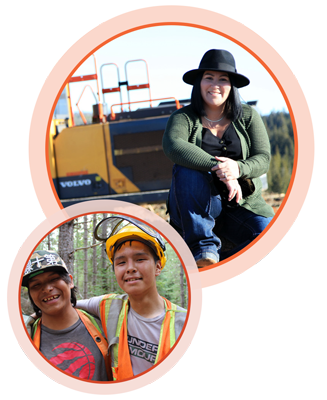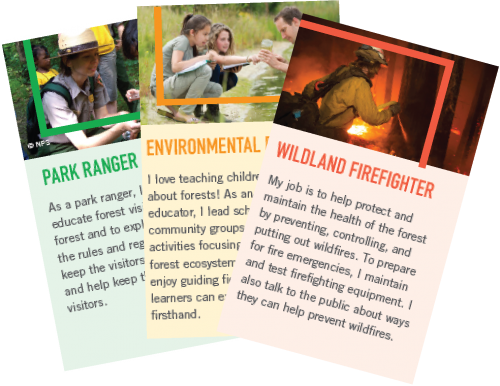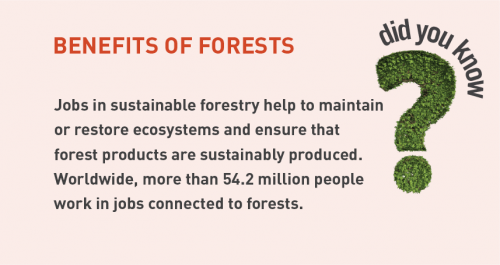 Key Concept: The forest sector generates diverse employment opportunities including foresters, natural resource managers, scientists, harvesting professionals, truckers, factory workers, engineers, architects, wildland firefighters, carbon modelers, and many more. [PLT’s Forest Literacy Framework, Concept 2.C.4]
Key Concept: The forest sector generates diverse employment opportunities including foresters, natural resource managers, scientists, harvesting professionals, truckers, factory workers, engineers, architects, wildland firefighters, carbon modelers, and many more. [PLT’s Forest Literacy Framework, Concept 2.C.4]
Objectives: Provide opportunities and materials for learners to
- Explore a variety of forest careers.
- Identify the training or education requirements and supporting skills for specific forest sector jobs.
Session Time: 50 minutes
Setting: Indoors or Outdoors
 Our society depends on forests for timber and other forest products, as well as for wildlife, clean air, water, and recreation. People in the forestry field work to manage forests sustainably so that forests provide all the things we need and want from them while remaining vigorous and healthy.
Our society depends on forests for timber and other forest products, as well as for wildlife, clean air, water, and recreation. People in the forestry field work to manage forests sustainably so that forests provide all the things we need and want from them while remaining vigorous and healthy.
Forestry is more than just planting trees, fighting forest fires, or harvesting logs, although managing those tasks may be part of a forester’s responsibilities. Forestry also includes professionals who specialize in individual parts of the forest, such as soils, water, or wildlife. Foresters also must have skills in the areas of soil science, hydrology, and wildlife management and can perform activities related to computer modeling, mapping, statistical and budget analysis, and education.
Materials:
Scissors and envelopes.
Get Ready:
Make copies of the career card worksheets, cut them apart to make sets, and put each set in an envelope to hand out to the learners. Invite one or more of your colleagues, ideally with different jobs, to talk with the group about their job, answering such questions as:
- What education, training, skills, and personal characteristics are needed for this job?
- Why did they choose this job?
- What is the most interesting – and the most challenging – thing about it?
- What does a typical day involve?
- What types of organizations or businesses hire people for this job?
- How is this job changing?
- Why is this job important?

Introduce
Ask learners their ideas for what resources are provided by forests, such as:
- Plant and animal habitats,
- Paper and wood products,
- Places for recreation, and
- Air, soil, and water protection.
Make the connection that forests can be managed by people to enhance each of these different resources. Challenge learners to identify jobs they can think of that are related to forestry.
Experience
- Divide the group into teams or pairs and give each a set of career cards. Challenge teams to categorize the jobs by different criteria such as indoor versus outdoor, high tech versus low tech, amount of interaction with other people, academic discipline, education level, and so on.
- Ask a few volunteers to name a green job that interests them and why. Encourage learners to think about the skills needed for the jobs and reflect on how those skills compare to their own strengths.
- Introduce your colleague(s) to the group and ask them to describe their job. Allow time for learners to ask questions.
Connect
Point out that many people who work in and for forests are motivated by a deep connection to nature. Invite learners to find something outdoors that they connect to, whether an object, feeling, or action. Encourage them to ask a question related to their observations and then consider what type of job or professional could help them find an answer.
Ask learners to think about what skills are necessary for the job that most interested them. Have them write down three skills they have that might make them well-suited for this job and three skills they might need to strengthen.
TAKE ACTION!
Challenge learners to create a new job or tool related to forests. Encourage them to think about a forest-related problem they would like to solve (such as litter or pollution) and then invent a job or tool to help solve it. For example, their job might involve a virtual reality teaching tool, a mobile app, or a new forest product.
 Learners discover a range of forest-related careers that help to maintain forest ecosystems and ensure that forest products are sustainably produced. Review or download the activity below.
Learners discover a range of forest-related careers that help to maintain forest ecosystems and ensure that forest products are sustainably produced. Review or download the activity below. 

 Key Concept: The forest sector generates diverse employment opportunities including foresters, natural resource managers, scientists, harvesting professionals, truckers, factory workers, engineers, architects, wildland firefighters, carbon modelers, and many more. [PLT’s Forest Literacy Framework, Concept 2.C.4]
Key Concept: The forest sector generates diverse employment opportunities including foresters, natural resource managers, scientists, harvesting professionals, truckers, factory workers, engineers, architects, wildland firefighters, carbon modelers, and many more. [PLT’s Forest Literacy Framework, Concept 2.C.4] Our society depends on forests for timber and other forest products, as well as for wildlife, clean air, water, and recreation. People in the forestry field work to manage forests sustainably so that forests provide all the things we need and want from them while remaining vigorous and healthy.
Our society depends on forests for timber and other forest products, as well as for wildlife, clean air, water, and recreation. People in the forestry field work to manage forests sustainably so that forests provide all the things we need and want from them while remaining vigorous and healthy.
